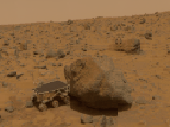Pathfinder Science Results Are In!
News story originally written on July 28, 1997
Though the Mars Pathfinder has just completed its third week on the surface of Mars, the mission has already shown itself to be extremely successful. In fact, the Pathfinder mission has fulfilled all of its primary science goals and is still operating flawlessly. More than 300 megabits of data were returned in the last week and Pathfinder project scientists are starting to release preliminary science findings. One such finding is the diversity of the rocks located very near the lander. Within close proximity of the lander area, there are many rocks of varying color and varying composition. In fact, the rover's spectral analysis has shown variance in the amount of iron within the rocks and the amount of weathering that the rocks in the surrounding area have undergone. The possibility is that these rocks are not volcanic as once hyphothesized, but rather they may be the result of a past impact event.
Although the rocks surrounding the Carl Sagan Memorial station show much diversity, the soil in the area does not. In fact, the three Sojourner anaylses are all quite similar to past Viking soil samples taken over 1000 kilometers away from the Pathfinder landing area. This implies that there is a globally homogeneous soil layer on Mars, probably the result of many years of mixing by the Martian winds. As a result, the Sojourner rover will continue to concentrate on analyzing rocks for the rest of the mission.















